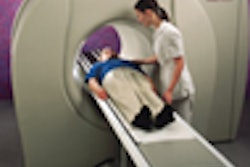"The challenge for radiologists is to help in the noninvasive differentiation between benign and malignant nodules -- in other words, to estimate their probability of malignancy. When small nodules are detected incidentally on CT scans, no standard approach for diagnostic work-up currently exists, to our knowledge," wrote Dr. David Yankelevitz and colleagues in the introduction to their paper in Radiology (October 2000, Vol.217:1, pp.251-256).
The group wanted to determine the accuracy of high-resolution CT volumetric measurements for assessing the growth and malignancy status of small pulmonary nodules. Images were acquired with a HiSpeed Advantage CT scanner in helical mode using 1-mm beam collimation.
Two sets of data were analyzed in this study. First, three experiments were performed with synthetic nodules, smaller than 1 cm in diameter, that were placed on synthetic foam that had an attenuation similar to an aerated lung. The goal was to compare volumetric measurements to area measurements.
The first experiment involved two repeat scans of a set of 21 calibrated acrylic spheres, each having a diameter of 3.96 mm, and two repeat scans of 29 highly calibrated spheres with diameters of 3.2 mm. The group reported that they found little difference between area and volume, and that the latter had an error rate of less than 2%.
In the second experiment, high-resolution CT scans were obtained of 20 silicone synthetic nodules that were 3 to 15 mm in diameter. The nodules were then intentionally deformed and rescanned.
"The amount of deformation of these nodules was considerable and was much greater than the change that would occur in the clinical situation, yet all repeat volume measurements at all sizes had a percentage error of 0.9% to 2.8%," they wrote.
For the last experiment, volumetric scans were obtained on 35 silicone synthetic nodules with diameters of 3 to 15 mm. In this case, there was a 2% to 3% variation between volume and mass measurements, particularly in the smaller nodules.
"Results from these synthetic nodule studies suggest that image resolution is adequate following isotropic resampling to determine change in volume within a 2% error," the authors wrote.
In order to demonstrate the clinical utility of volumetric measuring, a second set of data was obtained from 13 patients whose pulmonary nodules were initially less than 10 mm in diameter.
"Doubling times based on volume measurements were substantially smaller for malignant nodules than for benign nodules," the researchers noted. "By using volumetric measurements, all malignant nodules had a doubling time of less than 177 days. All of the benign nodules had doubling times that were 396 days or greater."
In addition, the 3-D technique was able to identify some asymmetric, malignant nodules that could not be seen with 2-D methods, they said.
The authors concluded that 3-D volumetric measurements offered several advantages: All available data can be taken from the whole nodule. Also, co-registration between multiple images is no longer an issue because total volume is measured. Finally, the nodule can be viewed from any arbitrary viewpoint.
"In our evaluation of the in vivo nodules, the doubling times estimated by means of volumetric techniques appeared to be more consistent with the final pathological diagnosis," they wrote.
Future studies will focus on honing this technique and developing a scheduling function to better understand whether the probability of growth can be linked to malignancy.
By Shalmali PalAuntMinnie.com staff writer
October 23, 2000
Related Reading
PET outperforms CT in detecting non-small-cell lung lesions, July 26, 2000
CT alone can evaluate lymph nodes in subset of patients with NSC lung cancer, June 23, 2000
Lung cancer staging with PET accurately greenlights more resections than CT, June 20, 2000
CT and SPECT explored to better classify lung nodules, January 28, 2000
Let AuntMinnie.com know what you think about this story.
Copyright © 2000 AuntMinnie.com

















